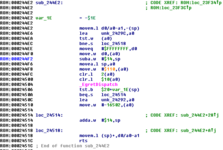I have a video of it showing up on my Macintosh TV which I believe was running 7.6 at the time:
I'm also pretty sure it would still come up after I installed its original 7.1, but I don't have video proof. But I just did some digging and found the dialog inside of System Enabler 404, which goes with the Macintosh TV. See DITL resource -16502. It's also in System Enabler 403 which was the enabler for the Performa/LC 520/550, and System Enabler 401 for the Color Classic. So maybe in System 7.1 it only showed up on a few specific Mac models that had enablers?
The same DITL also shows up in my System 7.5.5 system file that I installed in Basilisk II, so at least we know the message is lurking there in the background on machines after 7.1. I wonder how it decides whether or not to show it. The message doesn't pop up on my IIci running 7.5.3. Maybe there's code that only shows it on specific models? This might be an interesting, yet obscure, mystery to solve with some disassembly...
I'm also pretty sure it would still come up after I installed its original 7.1, but I don't have video proof. But I just did some digging and found the dialog inside of System Enabler 404, which goes with the Macintosh TV. See DITL resource -16502. It's also in System Enabler 403 which was the enabler for the Performa/LC 520/550, and System Enabler 401 for the Color Classic. So maybe in System 7.1 it only showed up on a few specific Mac models that had enablers?
The same DITL also shows up in my System 7.5.5 system file that I installed in Basilisk II, so at least we know the message is lurking there in the background on machines after 7.1. I wonder how it decides whether or not to show it. The message doesn't pop up on my IIci running 7.5.3. Maybe there's code that only shows it on specific models? This might be an interesting, yet obscure, mystery to solve with some disassembly...

